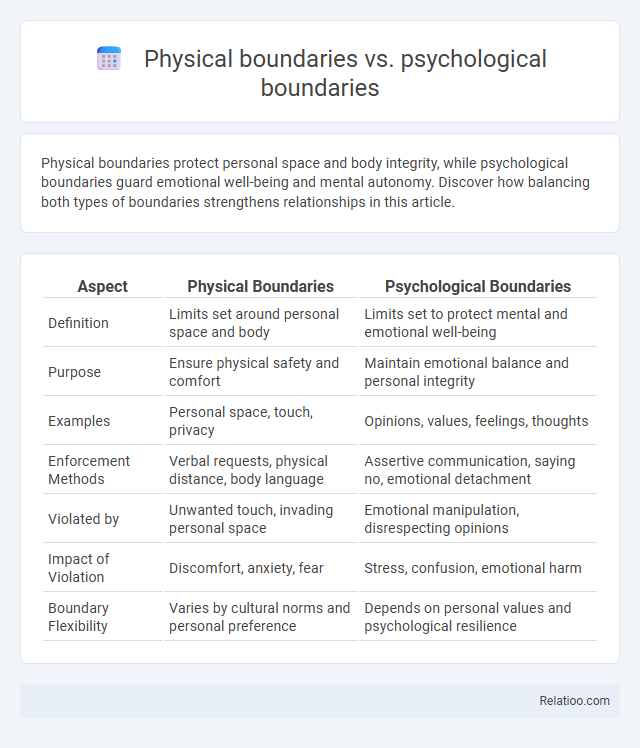Physical boundaries protect personal space and body integrity, while psychological boundaries guard emotional well-being and mental autonomy. Discover how balancing both types of boundaries strengthens relationships in this article.
Table of Comparison
| Aspect | Physical Boundaries | Psychological Boundaries |
|---|---|---|
| Definition | Limits set around personal space and body | Limits set to protect mental and emotional well-being |
| Purpose | Ensure physical safety and comfort | Maintain emotional balance and personal integrity |
| Examples | Personal space, touch, privacy | Opinions, values, feelings, thoughts |
| Enforcement Methods | Verbal requests, physical distance, body language | Assertive communication, saying no, emotional detachment |
| Violated by | Unwanted touch, invading personal space | Emotional manipulation, disrespecting opinions |
| Impact of Violation | Discomfort, anxiety, fear | Stress, confusion, emotional harm |
| Boundary Flexibility | Varies by cultural norms and personal preference | Depends on personal values and psychological resilience |
Understanding Physical Boundaries
Understanding physical boundaries involves recognizing personal space and bodily limits that define comfort zones in interactions. These boundaries protect individuals from unwanted touch or closeness, ensuring respect and safety in social and professional environments. Clear physical boundaries contribute to effective communication and help prevent conflicts by maintaining mutual respect.
Defining Psychological Boundaries
Psychological boundaries are the mental limits that define your emotional space and protect your sense of self, differentiating your thoughts, feelings, and responsibilities from those of others. Unlike physical boundaries that focus on tangible space, psychological boundaries regulate how much influence external factors have over your inner well-being. Clear psychological boundaries help you maintain personal integrity and emotional health by allowing you to manage interactions without feeling overwhelmed or intruded upon.
Key Differences Between Physical and Psychological Boundaries
Physical boundaries refer to the tangible limits set around personal space and physical touch, while psychological boundaries involve emotional limits and the separation of one's thoughts, feelings, and beliefs from others. Protection in this context means safeguarding these boundaries to maintain personal integrity, prevent emotional harm, and ensure mutual respect. Key differences include the visibility and enforcement methods: physical boundaries are often observable and enforced through body language or spatial distance, whereas psychological boundaries are internal and maintained through emotional regulation and assertive communication.
The Role of Consent in Physical Boundaries
Physical boundaries involve personal space and bodily autonomy, requiring explicit consent to ensure respectful interaction and prevent discomfort or violation. Psychological boundaries pertain to mental and emotional limits that protect an individual's inner world from intrusion or manipulation. Consent plays a crucial role in enforcing physical boundaries by affirming an individual's right to control and agree to physical touch or proximity, reinforcing both safety and respect in interpersonal relationships.
Emotional Safety and Psychological Boundaries
Psychological boundaries are essential for maintaining emotional safety by clearly defining personal limits regarding thoughts, feelings, and behaviors, preventing emotional exhaustion and manipulation. Unlike physical boundaries that protect one's bodily space, psychological boundaries guard mental well-being by fostering self-respect and resilience against external pressures. Protection through psychological boundaries creates a safe internal environment where individuals can express emotions without fear of judgment or violation, promoting healthier relationships and emotional stability.
Examples of Violating Physical and Psychological Boundaries
Physical boundaries involve personal space and bodily integrity, such as entering Your room without permission or unwanted touching. Psychological boundaries include respecting Your thoughts, emotions, and beliefs, exemplified by constant criticism or ignoring Your feelings. Violating these boundaries undermines trust and personal well-being, making it essential to recognize and assert protection measures in daily interactions.
The Impact of Ignoring Boundaries on Well-Being
Ignoring physical boundaries can lead to discomfort, injury, or threats to personal safety, while neglecting psychological boundaries often results in emotional distress, anxiety, or reduced self-esteem. Your well-being significantly deteriorates when boundaries are violated, as the mind and body both require clear limits to maintain balance and resilience. Protecting these boundaries is essential for preserving mental health and fostering a sense of security in relationships and environments.
Strategies for Setting Healthy Boundaries
Setting healthy boundaries involves clearly defining your physical limits by communicating personal space needs and ensuring your body's safety. Psychological boundaries require recognizing your emotional limits and asserting your right to your feelings without guilt or manipulation. Strategies like consistent communication, self-awareness, and assertiveness empower you to protect your well-being and maintain balanced relationships.
Navigating Boundaries in Relationships
Navigating boundaries in relationships requires recognizing the distinctions between physical boundaries, which involve personal space and touch preferences, and psychological boundaries, which pertain to emotional limits and mental privacy. Effective communication about these boundaries promotes mutual respect and prevents misunderstandings by ensuring that each person's comfort zones are acknowledged and honored. Protecting both physical and psychological boundaries fosters trust and emotional safety, enabling healthier and more balanced interpersonal connections.
Building Respect and Communication Around Boundaries
Physical boundaries involve personal space and touch limits, while psychological boundaries protect your emotional and mental well-being from intrusive thoughts or manipulative behavior. Building respect and communication around these boundaries requires clear expression of your needs and consistent reinforcement through assertive dialogue. Establishing these boundaries fosters mutual understanding, trust, and healthier relationships.

Infographic: Physical boundaries vs psychological boundaries
 relatioo.com
relatioo.com